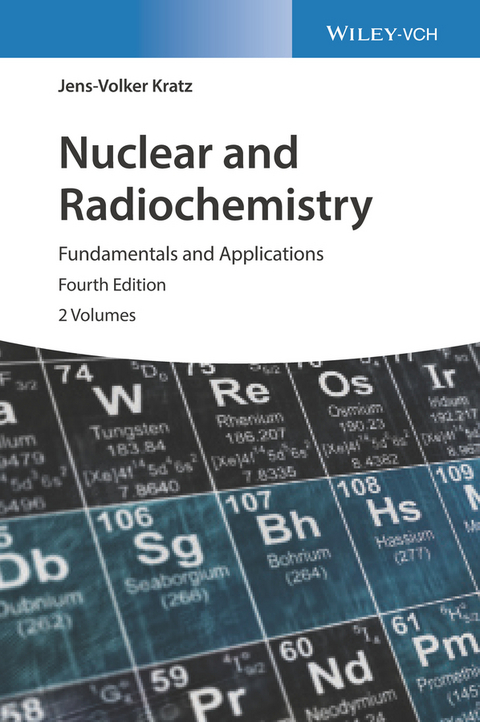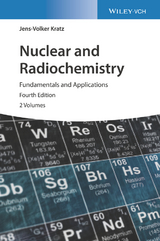Nuclear and Radiochemistry
Wiley-VCH (Verlag)
978-3-527-34905-0 (ISBN)
Jens-Volker Kratz is Professor Emeritus of Nuclear Chemistry at Johannes Gutenberg University in Mainz, Germany. He also obtained his degrees in Chemistry at this University, followed by a postdoc at Berkeley with Glenn T. Seaborg. Before moving back to Mainz, he worked as a Group Leader between 1974 and 1982 at GSI in Darmstadt. He has served as a member and chair of a number of scientific committees and is editor of Radiochimica Acta. He has received numerous prices, including the Otto Hahn Award.
1 Fundamental Concepts1.1 The Atom1.2 Atomic Processes1.3 Discovery of the Atomic Nucleus1.4 Nuclear Decay Types1.5 Some Physical Concepts Needed in Nuclear Chemistry1.5.1 Fundamental Forces1.5.2 Elements from Classical Mechanics1.5.3 Relativistic Mechanics1.5.4 The de Broglie Wavelength1.5.5 Heisenberg Uncertainty Principle1.5.6 The Standard Model of Particle Physics1.5.7 Force Carriers 2 Radioactivity in Nature2.1 Discovery of Radioactivity2.2 Radioactive Substances in Nature2.3 Nuclear Forensics 3 Radioelements and Radioisotopes and Their Atomic Masses3.1 Periodic Table of the Elements3.2 Isotopes and the Chart of Nuclides3.3 Nuclide Masses and Binding Energies3.4 Evidence for Shell Structure in Nuclei3.5 Precision Mass Spectrometry 4 Other Physical Properties of Nuclei4.1 Nuclear Radii4.2 Nuclear Angular Momenta4.3 Magnetic Dipole Moments4.4 Electric Quadrupole Moments4.5 Statistics and Parity4.6 Excited States 5 The Nuclear Force and Nuclear Structure5.1 Nuclear Forces5.2 Charge Independence and Isospin5.3 Nuclear Matter5.4 Fermi Gas Model5.5 Shell Model5.6 Collective Motion in Nuclei5.7 Nilsson Model5.8 The Pairing Force and Quasi-Particles5.9 Macroscopic-Microscopic Model5.10 Interacting Boson Approximation5.11 Further Collective Excitations: Coulomb Excitation, High-Spin States, Giant Resonances 6 Decay Modes6.1 Nuclear Instability and Nuclear Spectroscopy6.2 Alpha Decay6.2.1 Hindrance Factors6.2.2 Alpha-Decay Energies6.3 Cluster Radioactivity6.4 Proton Radioactivity6.5 Spontaneous Fission6.6 Beta Decay6.6.1 Fundamental Processes6.6.2 Electron Capture-to-Positron Ratios6.6.3 Nuclear Matrix Elements6.6.4 Parity Non-conservation6.6.5 Massive Vector Bosons6.6.6 Cabibbo-Kobayashi-Maskawa Matrix6.7 Electromagnetic Transitions6.7.1 Multipole Order and Selection Rules6.7.2 Transition Probabilities6.7.3 Internal Conversion Coefficients6.7.4 Angular Correlations 7 Radioactive Decay Kinetics7.1 Law and Energy of Radioactive Decay7.2 Radioactive Equilibria7.3 Secular Radioactive Equilibrium7.4 Transient Radioactive Equilibrium7.5 Half-life of Mother Nuclide Shorter than Half-life of Daughter Nuclide7.6 Similar Half-lives7.7 Branching Decay7.8 Successive Transformations 8 Nuclear Radiation8.1 General Properties8.2 Heavy Charged Particles8.3 Beta Radiation8.4 Gamma Radiation8.5 Neutrons8.6 Short-lived Elementary Particles in Atoms and Molecules 9 Measurement of Nuclear Radiation9.1 Activity and Counting Rate9.2 Gas-Filled Detectors9.2.1 Ionization Chambers9.2.2 Proportional Counters9.2.3 Geiger-Müller Counters9.3 Scintillation Detectors9.4 Semiconductor Detectors9.5 Choice of Detectors9.6 Spectrometry9.7 Determination of Absolute Disintegration Rates9.8 Use of Coincidence and Anticoincidence Circuits9.9 Low-Level Counting9.10 Neutron Detection and Measurement9.11 Track Detectors9.11.1 Photographic Emulsions and Autoradiography9.11.2 Dielectric Track Detectors9.11.3 Cloud Chambers9.11.4 Bubble Chambers9.11.5 Spark Chambers9.12 Detectors Used in Health Physics9.12.1 Portable Counters and Survey Meters9.12.2 Film Badges9.12.3 Pocket Ion Chambers9.12.4 Thermoluminescence Dosimeters9.12.5 Contamination Monitors9.12.6 Whole-Body Counters 10 Statistical Considerations in Radioactivity Measurements10.1 Distribution of Random Variables10.2 Probability and Probability Distributions10.3 Maximum Likelihood10.4 Experimental Applications10.5 Statistics of Pulse-Height Distributions10.6 Setting Upper Limits When No Counts Are Observed 11 Techniques in Nuclear Chemistry11.1 Special Aspects of the Chemistry of Radionuclides11.1.1 Short-Lived Radionuclides and the Role of Carriers11.1.2 Radionuclides of High Specific Activity11.1.3 Microamounts of Radioactive Substances11.1.4 Radiocolloids11.1.5 Tracer Techniques11.2 Target Preparation11.3 Measuring Beam Intensity and Fluxes11.4 Neutron Spectrum in Nuclear Reactors11.4.1 Thermal Neutrons11.4.2 Epithermal Neutrons and Resonances11.4.3 Reaction Rates in Thermal Reactors11.5 Production of Radionuclides11.5.1 Production in Nuclear Reactors11.5.2 Production by Accelerators11.5.3 Separation Techniques11.5.4 Radionuclide Generators11.6 Use of Recoil Momenta11.7 Preparation of Samples for Activity Measurements11.8 Determination of Half-Lives11.9 Decay-Scheme Studies11.10 In-Beam Nuclear Reaction Studies 12 Nuclear Reactions12.1 Collision Kinematics12.2 Coulomb Trajectories12.3 Cross-sections12.4 Elastic Scattering12.5 Elastic Scattering and Reaction Cross-section12.6 Optical Model12.7 Nuclear Reactions and Models12.7.1 Investigation of Nuclear Reactions12.7.2 Compound-Nucleus Model12.7.3 Precompound Decay12.7.4 Direct Reactions12.7.5 Photonuclear Reactions12.7.6 Fission12.7.7 High-Energy Reactions12.8 Nuclear Reactions Revisited with Heavy Ions12.8.1 Heavy-Ion Fusion Reactions12.8.2 Quasi-Fission12.8.3 Deep Inelastic Collisions12.8.4 "Simple" (Quasi-elastic) Reactions at the Barrier12.8.5 "Complex" Transfer Reactions12.8.6 Relativistic Heavy-Ion Collisions, the Phases of Nuclear Matter 13 Chemical Effects of Nuclear Transmutations13.1 General Aspects13.2 Recoil Effects13.3 Excitation Effects13.4 Gases and Liquids13.5 Solids13.6 Szilard-Chalmers Reactions13.7 Recoil Labeling and Self-labeling 14 Influence of Chemical Bonding on Nuclear Properties14.1 Survey14.2 Dependence of Half-Lives on Chemical Bonding14.3 Dependence of Radiation Emission on the Chemical Environment14.4 Mössbauer Spectrometry 15 Nuclear Energy, Nuclear Reactors, Nuclear Fuel, and Fuel Cycles15.1 Energy Production by Nuclear Fission15.2 Nuclear Fuel and Fuel Cycles15.3 Production of Uranium and Uranium Compounds15.4 Fuel Elements15.5 Nuclear Reactors, Moderators, and Coolants15.6 The Chernobyl and Fukushima Accidents15.7 Reprocessing15.8 Radioactive Waste15.9 The Natural Reactors at Oklo15.10 Controlled Thermonuclear Reactors15.11 Nuclear Explosives 16 Sources of Nuclear Bombarding Particles16.1 Neutron Sources16.2 Neutron Generators16.3 Research Reactors16.4 Charged-Particle Accelerators16.4.1 Direct Voltage Accelerators16.4.2 Linear Accelerators16.4.3 Cyclotrons16.4.4 Synchrocyclotrons, Synchrotrons16.4.5 Radioactive Ion Beams16.4.6 Photon Sources 17 Radioelements17.1 Natural and Artificial Radioelements17.2 Technetium and Promethium17.3 Production of Transuranic Elements17.3.1 Hot-Fusion Reactions17.3.2 Cold-Fusion Reactions17.3.3 48Ca-Induced Fusion Reactions17.4 Cross-sections17.5 Nuclear Structure of Superheavy Elements17.6 Spectroscopy of Actinides and Transactinides17.7 Properties of the Actinides17.8 Chemical Properties of the Transactinides17.8.1 Prediction of Electron Confi gurations and the Architecture of the Periodic Table of the Elements17.8.2 Methods to Investigate the Chemistry of the Transactinides17.8.3 Selected Experimental Results 18 Radionuclides in Geo- and Cosmochemistry18.1 Natural Abundances of the Elements and Isotope Variations18.2 General Aspects of Cosmochemistry18.3 Early Stages of the Universe18.4 Syntheses of Nuclei in Astrophysical Burning Processes18.4.1 Evolution of Stars18.4.2 Evolution of the Earth18.4.3 Thermonuclear Reaction Rates18.4.4 Hydrogen Burning18.4.5 Helium Burning18.4.6 Synthesis of Nuclei with A < 6018.4.7 Synthesis of Nuclei with A > 6018.5 The Solar Neutrino Problem18.6 Absolute Neutrino Masses18.6.1 From Pion Decay18.6.2 From Tau Decay18.6.3 From Nuclear beta-Decay18.6.4 The Karlsruhe Tritium Experiment on the Neutrino Mass KATRIN18.7 Interstellar Matter and Cosmic Radiation18.7.1 Interstellar Matter18.7.2 Cosmic Radiation18.7.3 Radionuclides from Cosmic Rays18.7.4 Cosmic-Ray Effects in Meteorites18.7.5 Abundance of Li, Be, and B 19 Dating by Nuclear Methods19.1 General Aspect19.2 Cosmogenic Radionuclides19.3 Terrestrial Mother/Daughter Nuclide Pairs19.4 Natural Decay Series19.5 Ratios of Stable Isotopes19.6 Radioactive Disequilibria19.7 Fission Tracks 20 Radioanalysis20.1 General Aspects20.2 Analysis on the Basis of Inherent Radioactivity20.3 Neutron Activation Analysis (NAA)20.4 Activation by Charged Particles20.5 Activation by Photons20.6 Special Features of Activation Analysis20.7 Isotope Dilution Analysis20.8 Radiometric Methods20.9 Other Analytical Applications of Radiotracers20.10 Absorption and Scattering of Radiation20.11 Radionuclides as Radiation Sources in X-ray Fluorescence Analysis (XFA)20.12 Analysis with Ion Beams20.13 Radioisotope Mass Spectrometry20.13.1 Resonance Ionization Mass Spectrometry (RIMS)20.13.2 Accelerator Mass Spectrometry (AMS)20.13.3 Measurements of Ionization Potentials 21 Radionuclides in the Life Sciences21.1 Survey21.2 Application in Ecological Studies21.3 Radioanalysis in the Life Sciences21.4 Application in Physiological and Metabolic Studies21.5 Radionuclides Used in Nuclear Medicine21.6 Single-Photon Emission Computed Tomography (SPECT)21.7 Positron Emission Tomography (PET)21.8 Labeled Compounds 22 Radionuclides in the Geosphere and the Biosphere22.1 Sources of Radioactivity22.2 Mobility of Radionuclides in the Geosphere22.3 Reactions of Radionuclides with the Components of Natural Waters22.4 Interactions of Radionuclides with Solid Components of the Geosphere22.5 Radionuclides in the Biosphere22.6 Speciation Techniques with Relevance for Nuclear Safeguards, Verification, and Applications22.6.1 Redox Reactions, Hydrolysis, and Colloid Formation of Pu(IV)22.6.2 Investigation of the Homologs Th(IV) and Zr(IV)22.6.3 Time-resolved Laser-induced Fluorescence22.7 Conclusions 23 Dosimetry and Radiation Protection23.1 Dosimetry23.2 External Radiation Sources23.3 Internal Radiation Sources23.4 Radiation Effects in Cell23.5 Radiation Effects in Humans, Animals, and Plants23.6 Non-occupational Radiation Exposure23.7 Safety Recommendations23.8 Safety Regulations23.9 Monitoring of the Environment23.10 Geological Monitoring of Radioactive Waste Index
| Erscheinungsdatum | 13.10.2021 |
|---|---|
| Verlagsort | Weinheim |
| Sprache | englisch |
| Maße | 170 x 244 mm |
| Gewicht | 2110 g |
| Themenwelt | Naturwissenschaften ► Chemie ► Physikalische Chemie |
| Naturwissenschaften ► Physik / Astronomie | |
| Schlagworte | Chemie • Chemie / Physikalische Chemie • Chemistry • Energie • Energy • Kernchemie • Kernenergie • Kern- u. Hochenergiephysik • Kern- u. Radiochemie • Nuclear & High Energy Physics • Nuclear and Radiochemistry • nuclear energy • Physics • Physik • Radiochemie |
| ISBN-10 | 3-527-34905-7 / 3527349057 |
| ISBN-13 | 978-3-527-34905-0 / 9783527349050 |
| Zustand | Neuware |
| Informationen gemäß Produktsicherheitsverordnung (GPSR) | |
| Haben Sie eine Frage zum Produkt? |
aus dem Bereich




